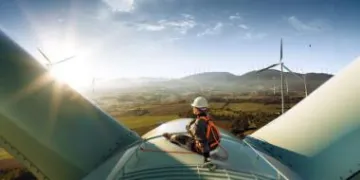Let’s have a look at the world at the mid-21st century, when today's newborns are about to finish graduate school. The world population has surpassed 9 billion, maybe even 10 billion people. Everybody needs housing and the infrastructure to get from one place to another, be it by rail in trams and trains or on the road, in hybrid or electric cars or even e-scooters. Clean energy technologies have been broadly introduced to deal with climate change. “Clean” or “green” energy that uses sources such as solar, wind, and geothermal power is prevalent, supported by smart electric grids and batteries.

The turn away from fossil-fuel-based to more renewable energy in this more densely populated world of 2050 requires more materials to build wind turbines, electric cars, solar panels, and batteries. Electric and hybrid vehicles use far more copper than conventional cars. The cloud-based computing and data storage that supports the control of renewable energy, electric grids, and our technology also require a lot of copper for the server farms. The internet of things, artificial intelligence, and all the aspects of the 4th industrial revolution depend on technology minerals.
Despite increased recycling efforts primary mineral demand from mining persists. As we try to mitigate climate change by shifting to more renewable energy, we will have to extract more minerals. Just how much more is something the World Bank has tried to estimate in its recent publication “Minerals for Climate Action: The Mineral Intensity of the Clean Energy Transition”. Out of 17 minerals in the scenario study, the demand might grow between 40% (titanium) and 350% (silver) in the highest-growth scenario. The demand for copper could grow between 12% and 213%, depending on the scenario.
It takes more copper per unit of energy generated for renewable energy than for fossil fuels, but despite their higher use of minerals renewable energy technologies emit greenhouse gasses at a fraction of fossil-fuel technologies. They still leave a carbon footprint that cannot be ignored if climate goals are to be fulfilled. Mining companies are CO2-intensive operations, mainly through the consumption of fossil fuels. Apart from energy use the mining industry has a social and environmental impact: To obtain the minerals we need for 21st century technologies and lifestyles, mining will inevitably be in closer proximity to communities and special ecosystems, and mines can have considerable long-term consequences for landscape and ecosystems.
To meet the triple challenge of energy use, environment and social impact that faces mining, building a low-carbon economy requires the cooperation of many disciplines.

The mining community must ensure that the climate footprint associated with the minerals they supply is minimized and make use of the numerous ways for mining companies to reduce energy consumption and improve energy performance. Clean-energy machinery and more efficient processing technology can play important parts. At the same time, reducing ore grades and depleting reserves force the development new techniques and technologies as mines must operate efficiently and respond to changing market conditions.
As general awareness of ecosystem fragility and critical species rises, this will become an even more sensitive area to manage. Lowered water tables due to mines high water usage can be a concern in drier climates, and acid mine water spills endanger local communities’ health and the environment. Air pollution comes in many forms, from sulfur to dust.
Mineral resources constitute an asset that can help otherwise less developed regions gain wealth, and mines can become important employers that create a range of jobs. But today’s approval processes for new mining projects that can draw out over decades show that the social license to operate has to be earned in cooperation with local communities.
All those factors play together to make supplying these resources ever more complex. Extraction and processing must be responsibly managed to avoid serious environmental and social implications. Innovation is necessary to reduce the amount of energy, water, and land when mining the much-needed minerals.

